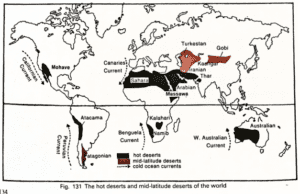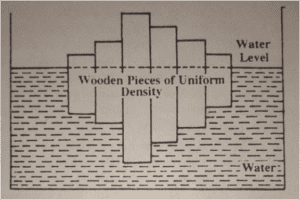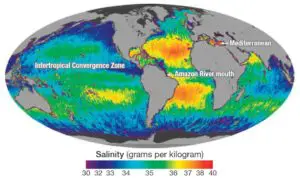Table of Contents
The Fundamental Concepts of Geomorphology
Geomorphology is a fascinating and diverse subject that involves the study of earth’s relief features and the processes that shape them. In this article, we will explore the most important principles of geomorphology known as the fundamental concepts of geomorphology. These concepts are crucial in understanding and interpreting landscapes.
Concept 1: The Principle of Uniformitarianism
According to this principle, the same physical processes and laws that operate today have been operating throughout geological time, although not necessarily with the same intensity. This principle, proposed by Hutton and popularized by Lyell, suggests that the present is the key to the past. For example, the wind deposits that formed the Navajo sandstone during Jurassic times followed different laws of wind flow compared to present-day wind deposits. This principle is also applied in predicting volcanic activity.
Concept 2: Geological Structure as a Dominant Control Factor
This concept highlights the importance of geological structures in the evolution of landforms. Geological structures include phenomena such as rock attributes, the presence or absence of structures, permeability of rocks, and more. These structural features of rocks are much older than the geomorphic forms developed upon them. The increasing application of geomorphic interpretation of aerial photographs is made possible by this principle.
Concept 3: Distinctive Imprints of Geomorphic Processes
Every geomorphic process leaves a distinctive imprint on landforms, and each process develops its own characteristic assemblage of landforms. This concept applies to both endogenetic processes like volcanism and earthquakes, as well as exogenic processes like weathering, mass wasting, and erosion. Landforms can be classified based on their genetic relationships, and this concept emphasizes the importance of understanding these relationships.
Concept 4: Sequence of Landform Development
As different erosional agencies act upon the Earth’s surface, a sequence of landforms with distinctive characteristics is produced at successive stages of their development. This idea is discussed in terms of geomorphic cycles, with metaphorical terms like “youth,” “mature,” and “old” used to designate stages of development. For example, every cycle of different geological processes follows this principle, and even partial cycles leave their imprint on the surface.
Concept 5: Complexity in Geomorphic Evolution
Geomorphic evolution is rarely influenced by a single process, and landscapes are more likely to be multicyclic rather than monocyclic. It is rare to find a landscape that has not been affected by multiple geomorphic processes. In some cases, older topography is seen on new landscapes, which are referred to as exhumed or resurrected landscapes.
Concept 6: Age of Earth’s Topography
Most of the Earth’s topography is no older than the Pleistocene, and topographic features that are ancient are rare. Those that do exist are likely exhumed forms due to degradation over geological time. For example, the majority of topographical features on the Himalayan range were formed during the Pleistocene age.
Concept 7: Influence of Pleistocene Changes
Proper interpretation of present-day landscapes requires a full appreciation of the manifold influences of geologic and climatic changes during the Pleistocene. The recognition that these changes have far-reaching effects on present-day topography is crucial. Glacial outwash and wind-blown materials of glacial origin can be found all over the world, particularly in the middle latitudes. Pleistocene diastrophism also played an important role in the formation of the Himalayas and the Grand Canyon.
Concept 8: Importance of World Climates
The operation of different geomorphic processes is influenced by climatic factors, such as temperature and precipitation. High altitude areas with specific climatic conditions impose modifications on these processes. Additionally, human activities can also have a significant influence on geomorphic processes.
Concept 9: Historical Extension of Geomorphology
While primarily concerned with present-day landscapes, geomorphology attains its maximum usefulness by considering historical aspects. A historical approach, also known as paleo-geomorphology, is necessary for proper interpretation. This approach involves the application of the principle of uniformitarianism and includes the study of stratigraphy and sedimentology. Overall, understanding these fundamental concepts of geomorphology is invaluable in interpreting and comprehending the complex and ever-changing landscapes of our planet.
Fun Fact:
The field of geomorphology is continuously evolving as new technologies, such as remote sensing and GIS, allow for more detailed and accurate analysis of Earth’s landforms and processes.
Mutiple Choice Questions
1. What is the underlying principle known as in Concept 1 of geomorphology?
a) Principle of uniformitarianism
b) Principle of structure
c) Principle of distinctiveness
d) Principle of complexity
Explanation: The underlying principle in Concept 1 of geomorphology is known as the Principle of uniformitarianism.
2. Who proposed the Principle of uniformitarianism?
a) Hutton
b) Lyell
c) Worcester
d) Ashley
Explanation: The Principle of uniformitarianism was proposed by Hutton and popularized by Lyell.
3. What is Concept 4 of geomorphology primarily focused on?
a) Geological structure
b) Genetic classification
c) Principles of erosion
d) Geomorphic cycles
Explanation: Concept 4 of geomorphology is primarily focused on the development stages of landforms and the concept of geomorphic cycles.
4. According to Concept 5 of geomorphology, landscapes influenced by a single geomorphic process are:
a) Multicyclic
b) Monocyclic
c) Resurrected
d) Exhumed
Explanation: According to Concept 5 of geomorphology, landscapes influenced by a single geomorphic process are rare, and landscapes are more likely to be multicyclic than monocyclic.
5. What is emphasized in Concept 8 of geomorphology?
a) Climatic factors
b) Geological structures
c) Landform classification
d) Human activities
Explanation: Concept 8 of geomorphology emphasizes the varying importance of different geomorphic processes influenced by climatic factors.
6. What is the term used to describe the historical approach in geomorphology?
a) Geomorphic cycles
b) Paleogeomorphology
c) Uniformitarianism
d) Genetic classification
Explanation: The term used to describe the historical approach in geomorphology is paleogeomorphology, which includes stratigraphy and sedimentology.
7. What is the main focus of geomorphology?
a) Interpretation of landscapes
b) Study of weather patterns
c) Analysis of plant species
d) Exploration of ocean depths
Explanation: The main focus of geomorphology is the interpretation of landscapes and the study of Earth’s relief features.
Brief Summary | UPSC – IAS
This article discusses the fundamental concepts of geomorphology. It explains that the same physical processes and laws that operate today have operated throughout geological time, although not always with the same intensity. Geological structure is a dominant control factor in the evolution of landforms. Geomorphic processes leave their distinct imprints upon landforms, each developing its own characteristic set of landforms. As different erosional agencies act upon the Earth’s surface, a sequence of landforms with distinctive characteristics is produced. Complexity is more prevalent than simplicity in geomorphic evolution. Most of the Earth’s topography is no older than the Pleistocene period. Proper interpretation of present-day landscapes requires an understanding of the geologic and climatic changes during the Pleistocene. Knowledge of world climates is necessary to understand the varying importance of different geomorphic processes. Finally, a historical approach to geomorphic landscapes is needed for proper interpretation.



